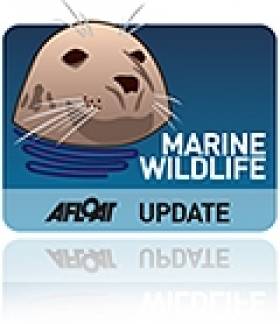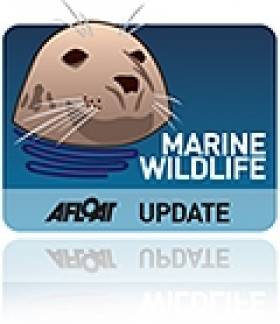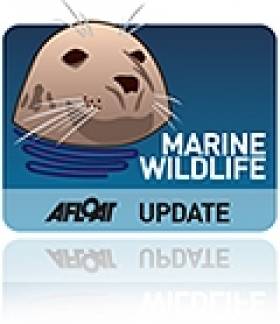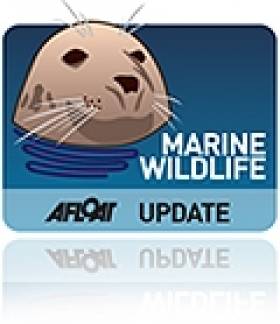Displaying items by tag: marine wildlife
Origins Of Fish Unique To Kerry Unveiled By Marine Scientists
#NewFish - A team of marine scientists from UCD, the University of Salford and Inland Fisheries Ireland (IFI) has reconstructed the origins of the endangered Killarney shad.
The fish is known locally as the ‘goureen’ - but many of the anglers who fish for salmon and trout on Lough Leane in Co Kerry are unaware of its presence in their waters.
The Killarney shad is a member of the herring family and lives in shoals, which often show up on the sonar screens of the water buses plying tourists around the lake.
But unlike its close relative the twaite shad, which is known to anglers who fish the tidal waters of the River Barrow at St Mullins in May each year, the Killarney shad believed to be unique to the waters of Lough Leane.
And the new research for the first time provides genetic evidence for the timing of colonisation of the lake by the species after the last glaciations ended.
While the researchers have shown the Killarney shad to be present In Lough Leane for thousands of years, the fish was only formally reported in 1911 by fisheries scientist Tate Regan.
According to IFI, the link between the rivers and sea can become blocked by natural processes or human intervention, such as the building of locks or weirs along a water course. Consequently, once ocean-borne fish may become trapped or ‘landlocked’ in freshwater lakes.
There are several examples of landlocked fish populations which have since adapted to living permanently in freshwater environments, but the evolutionary processes that lead to their origin have rarely been reconstructed.
The existing population of Killarney shad is now genetically isolated from its recent ancestor, the twaite shad. By examining DNA from fish caught in Lough Leane and shad from other areas, researchers were able to show that after the end of the last ice age, some twaite shad were trapped in the lake on two separate occasions.
One coincided with the retreat of the glacial ice sheet from the south west of Ireland some 16,000 years ago; and the other occurred around 7,000 years ago. The descendants of those colonisers interbred, giving rise to the Killarney shad.
Currently there are no natural or manmade barriers in the River Laune connecting Lough Leane to the sea – but the Killarney shad has become so adapted to its new habitat that no migration to the sea is needed for the completion of its life cycle.
While there are landlocked shad populations in the Italian Lake District and in Greece, the Killarney shad is the only example of landlocked shad to have survived in north western Europe. The fish is listed as ‘vulnerable’ on the recent Irish Red Data Book.
Surveys conducted by IFI since the early 1990s have confirmed the presence of the fish in Lough Leane in significant numbers, as well as successful spawning on an annual basis. But the major concern is that a catastrophic environmental event in Lough Leane could eliminate the entire genetic pool, given that the fish is only present in one location.
The Killarney shad is listed in the EU Habitats Directive and Killarney National Park has been designated as a Special Area of Conservation (SAC) for the shad.
"This fish is a unique element of Ireland’s aquatic biodiversity," said Minister of State Fergus O'Dowd. "The present research shines more light on this uniqueness, confirming that ‘evolution’ or change within a species is not something fixed and in the long-distant past."
The minister congratulated the research team on "these very remarkable findings", and noted that IFI head of R&D, Dr Cathal Gallagher, pointed to the importance of State agencies working with third-level institutions to combine applied and academic expertise.
The present research was funded by the Irish Research Council, with support from IFI, and was part of Dr Ilaria Coscia’s PhD, now at Leuven University, Belgium, supervised by Prof Stefano Mariani, now at the University of Salford.
'Davina' The Dolphin Saved By Flint Lifeboat In North Wales
#MarineWildlife - A dolphin from the Irish Sea that became stranded on sandbanks in the River Dee in North Wales was safely transported back to deeper waters aboard Flint’s inshore RNLI lifeboat.
RNLI volunteers from Flint were called to Airbus UK’s loading facility, just downstream from Saltney Ferry, at around 11.30am on Thursday morning (22 August) to attend to the dolphin that was in difficulty in the shallows of the river estuary.
RNLI lifeboat operations manager Alan Forrester confirmed that the crew put the dolphin inside a stretcher for transfer to the lifeboat, and that a representative from the British Divers Marine Life Rescue was on board to monitor the cetacean's condition.
"The dolphin is a fair size, so we’ll go at a very slow pace until we reach deeper waters, where we will be met by the Rhyl all-weather RNLI lifeboat," said Forrester during the mission.
The dolphin, originally named 'Dave', has since been renamed 'Davina' after she was identified as being female.
Davina was released around the North Rhyl Flats as if she were set free in any shallow waters it's feared she would become stranded again.
#MarineWildlife - BBC News reports that three killer whales from a community of orcas off the Scottish west coast have been spotted off the country's east coast for the first time since scientists began monitoring the group in the 1990s.
Mark Hosford of the Hebridean Whale and Dolphin Trust described the sighting as "a really exciting development".
He added: "The west coast community is thought to be the only resident population of orca in the British Isles, and understanding their behaviour and movements is crucial to the conservation of these remarkable creatures."
The group's normal range includes Scotland's north and west coasts to the west coast of Ireland, and is thought to comprise just nine older whales - which are also believed to be genetically distinct from other orcas in the North Atlantic, showing much closer similarity to Antarctic killer whales.
As reported on Afloat.ie earlier this year, marine wildlife experts fear that the group is now on the "brink of extinction".
Whale Watch Day This Sunday Makes Heritage Week List
#MarineWildlife - This Sunday's All-Ireland Whale Watch Day has made the list of The Irish Times' 40 things to do in Heritage Week 2013.
The Irish Whale and Dolphin Group (IWDG) will be hosting free, guided and land-based whale watching events at 16 headlands around the Irish coast from 2pm to 5pm this Sunday 18 August.
The purpose of the day is to raise awareness of the 24 cetacean species recorded in Irish waters by giving the general public the chance to see our whales and dolphins in their natural environment.
And as the group tells RTÉ News, the recent arrival of minke whales in great numbers spells "a good omen" for this Sunday's island-wide watch.
The IWDG has the full list of whale watch spots for this weekend HERE.
Whale Watch Ireland 2013 just one example of the wide range of activities taking place during Heritage Week from 17-25 August.
Other events on the water during the week include Victorian seaside celebrations in Kilkee, Co Clare on 21 August; a river walk along the Lee in Cork city centre on 24 August; lighthouse tours at Galley Head, Loop Head and Wicklow Head on 25 August; and the Galway Hooker festival, Cruinniú na mBád, this weekend 17-18 August.
#MarineWildlife - The Irish Whale and Dolphin Group (IWDG) has welcomed recent measures to protect deep-diving cetaceans from the potential effects of seismic survey noise.
The new measures have been implemented by the Petroleum Affairs Division (PAD) of the Department of Communications, Energy and Natural Resources and the National Parks and Wildlife Service (NPWS).
As a result, the environmental management plan for the 2D seismic survey of the Irish EEZ, being conducted by ENI Ireland BV in conjunction with the PAD, includes the establishment of a 'mitigation zone' along key parts of the continental shelf margin from which all seismic survey is excluded.
The management plan was informed by two projects recently conducted by the IWDG: the recently published Atlas of the Offshore Distribution of Marine Mammals in Irish Waters (funded by the the NPWS and the Marine Institute); and the Beaked Whale Passive Acsoutic Monitoring Pilot, conducted in the Rockall Trough and funded by the PAD.
Both these projects identified areas of the Irish shelf slopes as being of importance to deep-diving cetaceans such as beaked whales, sperm whales and pilot whales.
The mitigation zones implemented during the ENI/PAD 2D survey show how collected data can directly contribute to cetacean conservation in Irish waters, according to the IWDG.
In other news, the IWDG has been carrying out its own survey in North Kerry to investigate the use of Tralee Bay and Bandon Bay by bottlenose dolphins, and assess the potential for marine wildlife tourism in the region.
Since May, Drs Simon Berrow and Joanne O'Brien have ben working with the local community in Fenit and North Kerry to survey and record dolphins and other cetaceans to build up a better understanding of how they use the bays.
The IWDG has also deployed three C-PODs across the bays to acoustically monitor the area for dolphins.
"It has long been known that Tralee and Brandon Bays are the only site where the resident bottlenose dolphins in the Shannon Estuary occur," said Dr Berrow. "The bottlenose dolphins in the Shannon are a genetically discrete population with a relatively small population of around 120-140 individuals. The Shannon is protected for bottlenose dolphins but Tralee and Brandon Bays are not.
"Since the start of this project, which is funded by North and East Kerry Development, we have encountered bottlenose dolphins on every trip. Photo IDs have established them to be Shannon dolphins, and they have been detected acoustically on nearly 90% of days at some sites."
Celtic Mist, the IWDG's research vessel, has been joined by local boats in surveying the area and on Wednesday last (6 August) it encountered a large group of bottlenose dolphins in Brandon Bay - captured on video by local filmmaker James McCarthy:
Kilkee Kids Free Dolphin From Shallows
#MarineWildlife - The coastguard were beaten to the punch by a group of children who helped a stranded dolphin back into open water in Co Clare, as TheJournal.ie reports.
Kilkee Coast Guard were dispatched after reports that the striped dolphin was trapped in the shallow rock pools at Kilkee Beach, but the unit arrived on scene just in time to see the cetacean swim away unscathed.
The Irish Whale and Dolphin Group's Dr Simon Berrow confirmed to TheJournal.ie that locals had seen a number of other dolphins swimming in the area, at least one of which almost became stranded in shallow water.
'World's First' As Researchers Attach Camera To Basking Shark
#MarineWildlife - Marine researchers have attached a video camera to the dorsal fin of a basking shark off Donegal in what's described as a "world's first".
RTÉ News reports that the footage captured by the team from the Irish Basking Shark Project, who affixed their camera to the giant six-metre shark off Malin Head last month.
Team spokesperson Emmett Johnston remarked on the basking shark bonanza off Donegal at present, commenting that the research "haven't seen sharks in such good numbers since 2010".
As previously reported on Afloat.ie, the gathering of beasts was a surprise for an angling kayaker who posted his own video of being 'stalked' by a basking shark off the Inishowen Peninsula.
But he was never in any real danger as despite their fearsome appearance, the gentle giants live on a diet of plankton.
Doolin Dolphin Antagonised By Loutish Visitors
#MarineWildlife - The Irish Whale and Dolphin Group (IWDG) has urged people in Doolin to refrain from swimming with or even approaching Dusty the dolphin after it emerged the cetacean has been tormented by loutish visitors.
As reported on Afloat.ie last week, a woman was hospitalised after being struck by the dolphin's nose in what was just one of a spate of incidents involving the 14-year-old female bottlenose at the Co Clare town.
However the Irish Examiner reports that the marine mammal may only be reacting to antagonising behaviour such as fin grabbing by some swimmers and visitors in the Doolin area - with one group of campers allegedly trying to pour cider down her blowhole.
Speaking after the latest attack late last month, Dr Simon Berrow of the IWDG commented: "It is IWDG policy to discourage people swimming with whales and dolphins in Ireland. The risk is not only to humans but also to the dolphin as habituation to humans increases risk of injury or death to the dolphin.
"Around 80% of such interactions worldwide end up in the death or severe injury of the dolphins involved."
Teens Wanted For New Marine Wildlife TV Show
#OnTV - RTÉ is on the lookout for Irish teenagers to take part in a new marine wildlife documentary series shooting in Australia later this year.
Blue Zoo will follow a group of eight young people - four from Ireland and four from Australia - working together at the New South Wales Blue Zoo, assisting "dolphins, seals and turtles who have been rescued and rehabilitated or bored into human care in the park".
The show's producers are seeking 14- to 15-years olds with an interest in conservation work and making the world a better place - and who can explain why this would be their dream in 100 words or less.
RTÉ TEN has more on the story HERE.
#MarineWildlife - A humpback whale new to Irish waters has been confirmed by the Irish Whale and Dolphin Group (IWDG).
Photos of the humpback's fluke and dorsal fin captured by Nick Massett off Clogher and Sybil Heads in West Kerry at the weekend were examined by the IWDG's catalogue experts who have determined that the whale is a new arrival - and one with a fluke colouring that's rarely seen in Irish waters.
Details have since been sent to Allied Whale in the US state of Maine - which curates the North Atlantic humpback whale catalogue - to see if a match can be made among its database of more than 7,000 fluke images.
Meanwhile, Wildlife Extra reports that sailors in the Irish Sea are urged to keep a lookout for a large group of minke whales.
The group includes three juveniles and a calf previously spotted some 19 miles east of Ireland's Eye near Howth.
"Although sightings of Minke whale are to be expected in these waters, such a large group is a rare occurrence," said Danielle Gibas, sightings officer with the UK's Sea Watch Foundation, which is organising Britain's annual National Whale and Dolphin Watch this week till 3 August.
And in other cetacean news, scientists claim that dolphins call each other by name, calling back to the sound of their signature whistle but ignoring whistles that aren't theirs.
Herald.ie reports on the findings by marine scientists at the University of St Andrews, who studied a bottlenose dolphin group off the east coast of Scotland.
Using underwater speakers, they played synthesised versions of dolphin whistles they'd identified with particular dolphins to determine their reactions.
They were surprised to find that individuals called back after hearing their own 'name' but ignored others, whether they were for dolphins in the same group or strangers.

































































